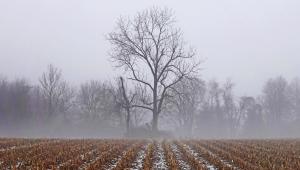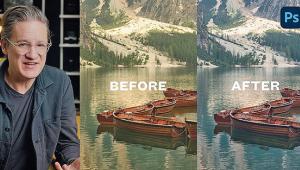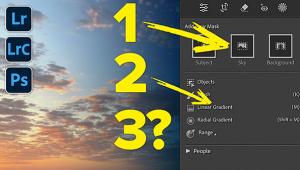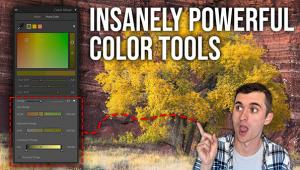Multiple Exposure Zoom Effects
Multiple Exposure Zoom Effects
Special Effects Made Easy
by Howard Millard
For a dynamic new look, put several captures on top of each other in a single image to multiply impact and open up new avenues to creative expression. Whether you want to inject motion into a static shot or add drama to a portrait, multiple exposure offers a myriad of possibilities for people, landscapes, flowers, and architecture—almost anything you can aim your lens at. It’s no longer necessary to make complicated exposure calculations and shoot everything in-camera. In fact, with many digital models, it’s not even possible to make multiple exposures in camera.
Creating multiple exposure images is rather easy. Fine-tuning them for a striking, professional result can require some care, but isn’t brain surgery. I’ll show you how to do it with Adobe Photoshop CS4, but most advanced image editors have this capability, including CS2, CS3, and Adobe Photoshop Elements 6 and 7.
At first glance, it might seem that creating a multiple exposure in-camera would be the quickest and easiest route. In a few instances, that might be true. However, for critical alignment and blending of different elements of different photos, combining images with software excels. You have much more flexibility in shooting as well, since every shot in a sequence doesn’t have to be perfect. You can pick your component images from photos shot anywhere and anytime, and use just the best for your multiple. By adding separate images, each on their own layer, you have great freedom and flexibility to accurately and precisely position each element where you want it. Further, layer mask capability makes it possible to “brush” in or out the elements that you want visible.
Portrait Composite
1. To create a multiple exposure zoom portrait, I began with this photo of Kayla. I expose normally. Although some advocate under- or over-exposing for a multiple image, I find that this is an extra and unnecessary step since with software you can vary the opacity of each layer and/or adjust its exposure with levels or curves. I first saved a copy of my raw file in the Photoshop .psd format, enabling me to use layers. Do the same if you’re starting with a JPEG.
 |
|
|
2. My aim is to have successively smaller versions of the portrait diminishing in size toward the center. In the layers panel shown here I dragged the background layer onto the new layer icon at the bottom of the layers panel to create a new duplicate layer of the background. You can also go to the menu and choose, Layer>New>Layer from Background. I renamed it Layer 2 and clicked on it in the layers panel to make it active.
 |
|
|
3. Since I want to make only the woman get smaller, not the background, I need to select her. I used the new CS4 Quick Selection tool, but you could use any Selection tool such as Color Range, the Magnetic Lasso, or the Magic Wand. Then, in the Options Bar, I clicked the new CS4 Refine Edges button. I adjusted the Radius and Contract/Expand sliders to fine tune the edges.
 |
|
|
4. After clicking OK, I went to the layers panel and turned off visibility of the original background layer by clicking off the eye icon at the left of that layer. Now, with Layer 2 active, I can see details where I selected the background behind the model. Once I am happy with the selection, I press the delete button on the keyboard (backspace key on Windows) to delete everything in the selected area. Since this is a layer, the selected areas are now transparent, indicated by a grey and white checkerboard pattern in Photoshop. Next, I choose Command-D (Control-D on Windows) to delete the selection. I’m now left with a silhouetted (cutout) portrait of Kayla against a transparent background which I will now use to create the additional multiple exposures at different sizes.
 |
|
|
5. Next, in the layers panel, click the eye icon for the background (original) layer to make it visible. Next, Cmnd-click (Ctrl-click Windows) on the thumbnail for Layer 2 to select it. Then go to menu and choose Edit>Transform>Scale. By holding the shift key while dragging one of the corner handles inward, you can re-size the portrait. As I do this, the options bar below the menu at the top of the screen shows the percentage that I’m downsizing. After dragging and evaluating the size I want, I decide to add two downsized layers, each one about 20 percent smaller than the previous one.
 |
|
|
6. After pressing Cmnd-D (Ctrl-D Windows) to delete the selection, I use the move tool (press V on the keyboard) to reposition Layer 2’s downsized portrait within the original. I don’t like the sharp bottom edges of the downsized image, so I add a layer mask to soften and mask lower parts of Layer 2.
To do this, I click on the new layer mask icon at the bottom of the Layers panel. This creates a new rectangular white layer mask icon in the layers panel to the right of the thumbnail image for that layer. I make sure this mask is active by clicking once on it, then I choose a small soft edged brush from the toolbar, and paint (with black as the foreground color) over the areas of the Layer 2 photo that I want to mask out.
 |
|
|
7. To create a third layer with an even smaller portrait, I repeat the last steps, dragging Layer 2 to the new layer icon at the bottom of the layers panel to create Layer 3. (Photoshop labels it “Layer 2 copy,” but I change the name to Layer 3 to make it easier to keep track of. Next, I select Layer 3 and use the Transform tool to downsize it as described in the previous step. I do a bit more masking at the bottom of the new layer.
This final triple zoom image adds dynamism and dramatic flair to the youthful portrait.
 |
|
|
8. In the Layers panel, you now see the three layers and masks of the final composite.
 |
|
|
Still Life
9. I wanted to try this effect with a still life. Strong edges around the subject are important to clearly delineate the different multiples. I photographed this mounted butterfly and silhouetted it against a white background.
 |
|
|
10. Using the same techniques I used for the portrait, I made copies of the butterfly and reduced each by the same percentage, then repositioned the copies directly on top of each other, as seen here in the Layers panel.
 |
|
|
11. The result is the creation of a new species, the imploding insect. While this is an intriguing image, especially printed large, I wasn’t yet satisfied.
 |
|
|
12. Starting anew with my selected butterfly, I again made multiple copies, each on its own layer at a smaller size. I experimented with positioning them vertically, horizontally, and diagonally on a white background. It was all too static. Next, I used the Transform tool to rotate each butterfly layer about 33?, and arranged them diagonally. Instead of white, I added a blue background with the Gradient tool. Next, I offset the top butterfly slightly.
To inject some movement, after duplicating the top “butterfly 4” layer, I moved the copy below it in the layer stack, and renamed it “butterfly 4 blur.”
 |
|
|
13. With the new copy layer active, I chose Filter>Blur>Motion Blur and set the Angle to 33? and the Distance to 257. Then I used the Move tool to reposition the blur layer out behind and below the top butterfly. To fine tune it, I lowered the opacity of this blur layer.
 |
|
|
14. Now I had created a multiple exposure image with multiple layers of interest—graduated sky background, receding subject size, diagonal design, and motion blur.
 |
|
|
Contacts
Adobe Systems Inc.
800-833-6687
www.adobe.com
- Log in or register to post comments












































